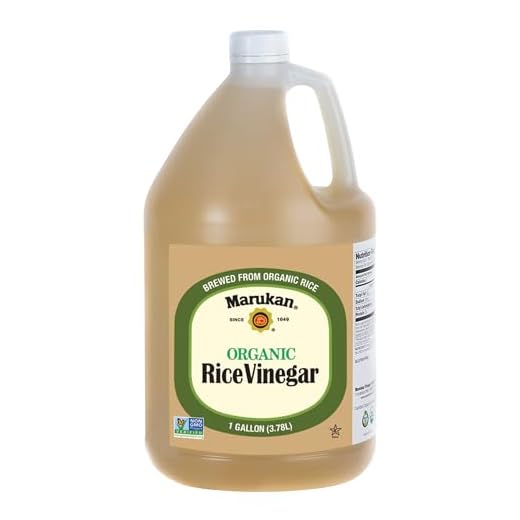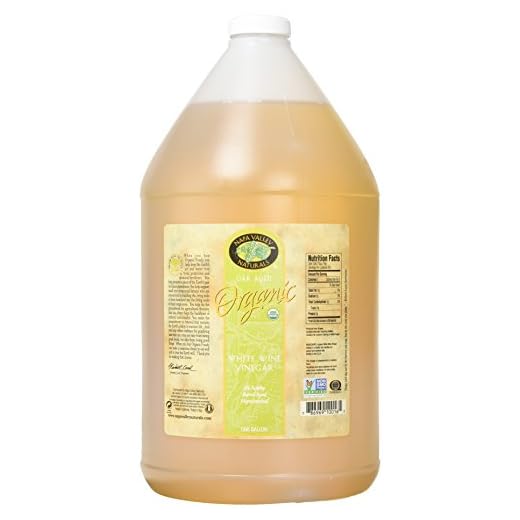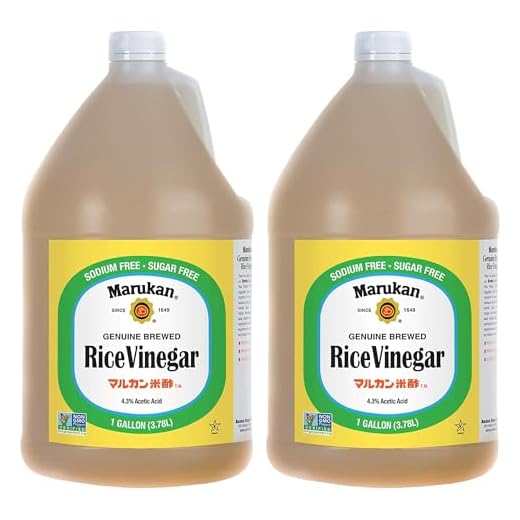



Yes, the acidity found in white wine alternatives can complement Asian dishes effectively, though the flavor profile may differ. The inherent sharpness of these alternatives can enhance the overall taste of stir-fries, dressings, and marinades.
When considering a replacement, it’s wise to account for the sweetness levels. The tangy notes of white grape-based products tend to be more pronounced, which could alter the intended flavor of the dish. If the recipe relies on the subtle sweetness of rice variants, adjusting the quantity or adding a touch of sugar might be necessary.
Experimentation is key. I suggest starting with a smaller amount and tasting as you go. This approach allows you to gauge how the dish evolves with the new ingredient. With some culinary creativity, you can achieve a delightful balance that suits your palate.
Substituting Different Types of Vinegar
Using an alternative acidic ingredient can work well in various recipes, particularly when it comes to dressings and marinades. However, the distinct flavor profiles of each option should be considered to achieve the desired taste. The tartness of a particular vinegar can significantly affect the end result of your dish.
If you’re looking for a practical replacement, the acidity level and flavor notes are key. Generally, a mixture of white vinegar and a hint of sugar can mimic the sweetness found in the other type, delivering a balanced outcome. Try combining equal parts of this blend to match the acidity and sweetness of the original ingredient.
For those interested in alternative uses, it’s also worth noting how vinegar can play a role in cleaning. If you’re curious about safe cleaning practices, check out this expert advice on using bleach on stainless steel.
In culinary applications, always taste as you go. Adjustments may be necessary to get the flavor just right, especially when working with different types of dishes. Experimentation often leads to delightful discoveries!
Understanding the Flavor Profiles of White Wine Vinegar and Rice Vinegar
The profile of a common fermented grape product offers a sharper and more complex acidity compared to a milder, slightly sweet flavor derived from fermented rice. The former brings forth notes of fruity, floral, and herbal elements, creating a deliciously tangy experience. On the other hand, the latter tends to be subtler, with a gentle sweetness and a hint of nuttiness that complements Asian cuisines beautifully.
Flavor Nuances
A fermented grape product can enhance dishes with its pronounced acidity, making it suitable for dressings, marinades, and sauces where a zesty kick is desired. In contrast, the rice counterpart is perfect for lighter dishes, such as sushi or salads, where a delicate flavor is preferred. The choice between these two depends largely on the dish in question and the flavor profile you aim to achieve.
Culinary Applications
<pWhen considering culinary applications, the grapey acidity excels in Mediterranean recipes, while the rice variant harmonizes well with stir-fries and dipping sauces. Understanding these distinctions will help you make better decisions in the kitchen and elevate your culinary creations to new heights.
When to Use White Wine Vinegar as a Rice Vinegar Alternative
Utilizing this alternative is ideal in specific culinary scenarios. Here are key instances to consider:
- Dressings and Marinades: When crafting light dressings or marinades, this option adds a pleasant acidity without overpowering the other ingredients. It’s particularly effective in vinaigrettes paired with greens or grilled vegetables.
- Cooking Techniques: In stir-frying or sautéing, this liquid can enhance flavors without masking the dish’s core tastes. Use it in recipes where a subtle tang is desired, such as in Asian-inspired dishes.
- Pickling: For quick pickling, this alternative can work well. It imparts a nuanced flavor suitable for vegetables and fruits, offering a different profile that complements the pickling spices.
- Flavor Balancing: When a dish requires a touch of acidity but lacks the specific notes characteristic of the original, this option can bridge the gap and enhance overall taste harmony.
I recommend experimenting with proportions. Start with a smaller amount, adjusting to your preference. Each dish is unique, and personal taste plays a significant role in achieving the desired flavor profile.
How to Adjust Recipes When Substituting Vinegars
When altering recipes, the acidity level of the liquid plays a significant role in achieving the desired taste. Here are some practical steps to fine-tune your dishes:
- Adjust Acidity: If the replacement has a stronger acidity, reduce the amount slightly. For example, if a recipe calls for 1 tablespoon of your original liquid, try starting with 2 teaspoons of the alternative.
- Taste as You Go: Always sample your dish as you incorporate the new ingredient. This allows you to gauge the flavor balance and make necessary adjustments.
- Enhance Sweetness: If the substitute is less sweet, consider adding a touch of sugar or honey to mimic the original’s sweetness levels.
- Incorporate Aromatics: To replicate the depth of flavor, add herbs or spices that complement your dish, enhancing the overall profile.
- Use Cooking Techniques: If the dish allows, cooking down the replacement can mellow its acidity, making it more similar to the intended ingredient.
By following these guidelines, you can ensure that your culinary creations remain delicious and balanced, even with ingredient modifications.
Potential Dishes that Benefit from Using White Wine Vinegar
For a refreshing summer salad, try using this tart liquid in a vinaigrette. Combine it with olive oil, Dijon mustard, and honey for a delightful dressing that enhances mixed greens, cherry tomatoes, and cucumbers.
In marinades for grilled chicken or fish, the bright acidity complements the proteins beautifully. Mix it with herbs like thyme or rosemary, garlic, and a touch of citrus zest for a flavorful blend.
When preparing a classic ratatouille, adding a splash of this tangy ingredient during cooking helps to balance the sweetness of the vegetables, elevating the dish’s overall flavor profile.
In sauces, particularly those based on tomatoes, this ingredient can add a nuanced sharpness. Incorporate it towards the end of cooking for the best impact.
For pickling vegetables, this option works well. Combine it with water, sugar, and spices to create a quick pickle brine for cucumbers, carrots, or red onions.
In risottos, a drizzle during the cooking process not only enhances the dish’s creaminess but also adds a layer of depth. Pair it with mushrooms or asparagus for a seasonal touch.
| Dish | Usage |
|---|---|
| Summer Salad | Vinaigrette dressing with olive oil and honey |
| Grilled Proteins | Marinade with herbs and citrus zest |
| Ratatouille | Balancing sweetness of vegetables |
| Tomato Sauce | Add at the end for sharpness |
| Pickled Vegetables | Quick pickle brine with sugar and spices |
| Risotto | Drizzle during cooking for creaminess |
Possible Drawbacks of Using White Wine Vinegar Instead of Rice Vinegar
Choosing a different acidity source can lead to unexpected outcomes in your dishes. The primary concern lies in the flavor profile; the alternative has a sharper and more pronounced taste, which can overpower subtler flavors typical in Asian cuisine. This is particularly relevant in dressings or marinades where the delicate balance is key.
Another issue is the sweetness level; the alternative is generally less sweet compared to its counterpart. Many Asian dishes rely on the mild sweetness of rice vinegar to achieve harmony, so using a more acidic option may alter the intended taste dramatically.
Texture can also be affected. In recipes where a specific consistency is desired, substituting with a different acidity source might yield a thinner or more liquid result, impacting the overall mouthfeel of the dish.
Lastly, the aroma is distinct. The floral and fruity notes of the alternative can clash with traditional flavors found in many Asian dishes, potentially leading to an unappealing scent that detracts from the overall dining experience.
Other Vinegar Alternatives for Rice Vinegar
Apple cider option excels in salads and marinades, offering a mild sweetness that complements dishes where a delicate balance is needed. Use it in dressings or as a finishing touch for roasted vegetables.
Champagne variant provides a light, crisp flavor profile. Ideal for vinaigrettes or seafood dishes, it enhances without overpowering. This choice works well in recipes that require a subtle acidity.
Sherry alternative introduces a nutty, complex taste. It’s perfect for sauces and reductions, adding depth to stews or hearty casseroles. Adjust quantities based on personal preference to achieve desired flavor intensity.
Lemon juice serves as a fresh, zesty substitute. Its brightness is great for marinades or dressings, offering a different but refreshing tang. Be mindful of the acidity level and adjust other ingredients accordingly.
Distilled option is a straightforward choice, providing sharp acidity without additional flavors. Use it when you want a clean profile, especially in pickling or straightforward recipes.
Each alternative brings unique characteristics, so experimenting with different types can help you discover new flavor combinations that enhance your dishes.
Expert Tips for Successful Substitution in Cooking
Start with a lower quantity of the alternative liquid, around 75% of what the recipe calls for, and adjust according to taste. This approach minimizes the risk of overpowering other flavors in the dish.
Consider balancing acidity by adding a pinch of sugar or a splash of lemon juice if the alternative is sharper than the original. This can help mimic the milder profile of the traditional ingredient.
In recipes requiring a delicate touch, such as dressings or marinades, always taste as you go. The flavor transformation can be significant, and personal preferences play a crucial role.
For dishes that rely heavily on the original ingredient’s characteristics, like sushi or certain Asian recipes, use the alternative sparingly. It’s often better to enhance rather than replace the original flavor.
Experiment with blending in complementary flavors. Herbs, spices, or even a bit of broth can help round out the taste when using a different liquid, creating a harmonious blend.
Keep in mind the cooking method. If the dish involves simmering or reducing, the alternative may concentrate differently, impacting the final flavor. Adjust the quantity accordingly to maintain balance.
Lastly, document your adjustments for future reference. Keeping track of what worked and what didn’t will improve your confidence and skill in the kitchen over time.







